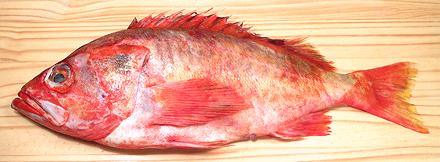 [Sebastes reedi]
[Sebastes reedi]
This Pacific rockfish is found all along the Aleutian Island chain down to northern California, living in deep water over rough bottoms. It can live to 100 years and can grow to 22 inches, but the photo specimen was 18-1/2 inches and 3 pounds 6 ounces. This fish is rather rare in the Asian markets here in Southern California. Fishing regulations for rockfish are quite strict, limiting supply, so they are unlikely to be found in markets far from the Pacific Coast. Photo © cg1.
More on Rockfish.
Yellowmouth Rockfish is an excellent eating fish with white, moderately flavored flesh that holds together well with any cooking method - sometimes a little too well. It flakes apart reluctantly into very large flakes and it can be almost a little chewy. Definitely it'll hold up in soups. As an overall impression, it is much like cod.
Cooking: This fish holds together very well, so is suitable for all common methods of cooking. If you poach fillets, even though they have been skinned they will curl moderately to the skin side. It is best to split them in half lengthwise and have long pieces rather than wide pieces. If pan frying, keep in mind these fillets, especially at the head end, are very thick, so fry over rather low heat so they're cooked through by time they're browned. Coat lightly with rice flour to prevent sticking to the pan.
Scales: The scales are medium size with fairly good adhesion. They scrape off with a bit of effort and fly around moderately. In some spots the scales may simply fold over rather than scrape off. In these areas just pull them off with long nose pliers.
Cleaning:
Use your filleting knife, sharp edge out, to cut from the vent to the fins, then your kitchen shears to cut from the fins up to the chin. You will have to use your kitchen shears to cut the esophagus and the ends of the gill arches, and a few other spots because this is a large fish and the gills are large and pull rather hard.
Fillet: Yellowmouth Rockfish has a complete and orderly bone structure making it very easy to fillet.
Note: The skirt area is best cut off and used separately because the inside membrane shrinks severely and cannot be removed. While fairly meaty, it can have an "off" flavor, depending on the condition of the fish, If the lining is glossy gray-black it is likely OK, but if muddy looking it should be discarded.
Skin: The skin does not have a strong or off flavor, but it shrinks severely when heated. This is, however, a very easy fish to skin using the long knife and cutting board technique. It is best to skin the skirts (if used) separately as they make the fillet very wide. While skin must be removed from fillets so it will curl them into a sausage shape, you can bake a moderate size fish whole, but do make a few diagonal slashes half way through the flesh so the skin won't tear it up and make it look really ugly. Those cuts will open up wide, but that just lets the sauce in.
Yield: A 3 pound 6 ounce fish yielded fillets weighing 1 pound 8-3/8 ounces skin-on (45%), 1 pound 6 ounces skin-off (41%), which is very good for a large head fish like this. A smaller fish will yield a bit less, a larger fish a bit more.
Stock: The head, bones and fins (the skins could also be used), simmered slowly for 1/2 hour,make a light flavored stock that is quite usable, but is not quite clear so it should not be used for applications requiring a very clear stock. The stock has a moderate amount of oil which should be removed using your gravy separator.
sf_rockymz* 100411 - www.clovegarden.com